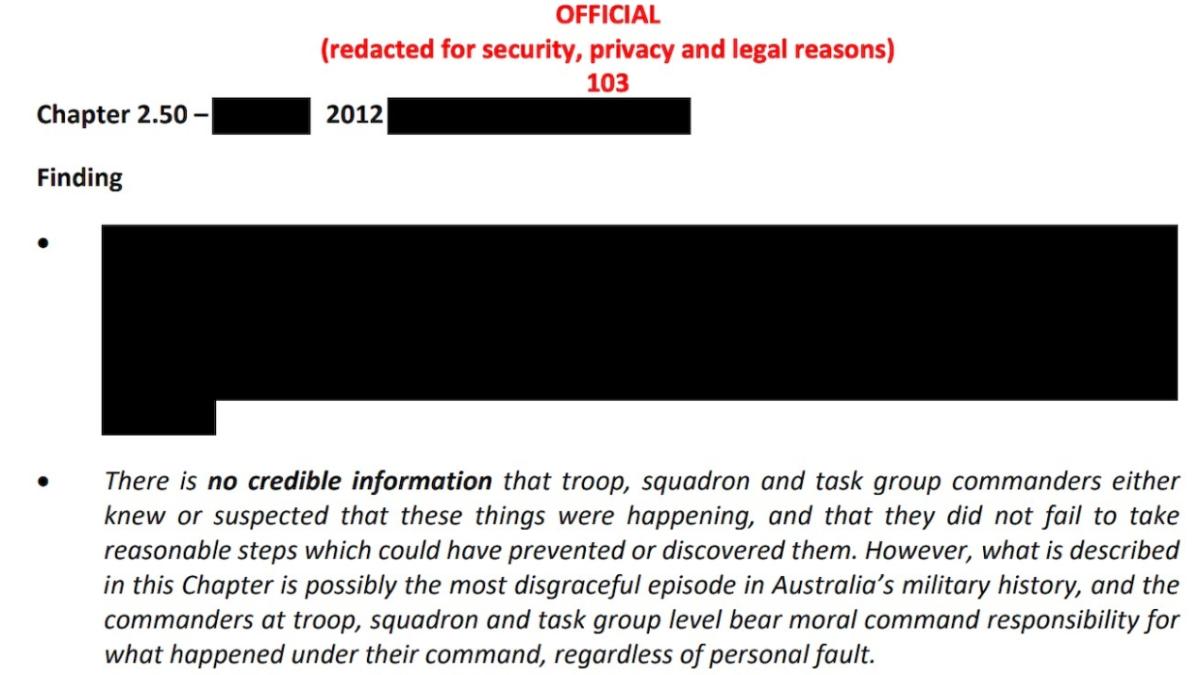
After four years of investigating, the Afghanistan Report Inquiry has finally been made public, detailing horrific war crimes allegedly committed at the hands of Australian soldiers who were deployed to *help* the situation.
The report (which you can read in full here) is 425 pages long, but is heavily redacted, concealing the identities of all parties involved.
To summarise, the report covers the alleged unlawful killing of 39 people across 23 separate incidents, involving a total of 25 Australian special forces personnel. Judge Paul Brereton has recommended that 19 personnel be referred to the Australian Federal Police for further investigation.
In addition to the alleged murder of 39 civilians, the report also revealed that troops actively tried to cover up the killings, often planting evidence to make the victims appear armed or dangerous.
The entire situation is absolutely abhorrent, and should be of our nation’s greatest shames. But if you’re not interested in reading the full 425-page report, you should at least know some of the worst allegations made against our troops.
WARNING: The following allegations are graphic and violent in nature, some readers may find this distressing.
“What is described in this Chapter is possibly the most disgraceful episode in Australia’s military history,” Chapter 2 of the report – Incidents and Issues of Interest – reads.
Perhaps one of the most horrific allegations revealed in the report was the process of “blooding,” in which, junior members were directed to kill a person under control as a sort of horrific rite of passage that would later be covered up.
“Typically, the patrol commander would take a person under control and the junior member, who would then be directed to kill the person under control. ‘Throwdowns’ would be placed with the body, and a ‘cover story’ was created for the purposes of operational reporting and to deflect scrutiny. This was reinforced with a code of silence,” the report states.
Although many of the details have been redacted for security reasons, there are pages upon pages of similar allegations in which the report found “credible information” to support. Examples include:
“REDACTED NAME and REDACTED NAME expressly or implicitly directed or encouraged REDACTED to kill the male Afghan local national.”
Despite not revealing names or identifying details, the chapter paints a clear picture of the alleged repeat offenders, with multiple instances of military personnel having numerous allegations against them.
One person in particular (Ch 2.13) has numerous allegations of at least three unlawful killings, the planting of evidence, deleting potentially damning images and encouraging or directing another person to kill a number of Afghan males, among other allegations.
- “REDACTED willfully and unlawfully killed of an Afghan male REDACTED, when he was under control and unarmed and posing no threat, by shooting him.”
- “REDACTED placed a REDACTED with the body of REDACTED for the purposes of exposing sensitive site exploitation imagery which would falsely convey that REDACTED was being carried by REDACTED when engaged, in order to disguise that he was hors de combat and create the false appearance that he was a combatant and to deceive future inquires.”
- “REDACTED deleted sensitive site exploitation photographs which had been taken by REDACTED which showed REDACTED and substituted or caused to be substituted in the
official sensitive site exploitation record other photographs, which showed REDACTED,
in order to destroy evidence inconsistent with an innocent explanation of the death of REDACTED.” - “REDACTED failed to exercise control properly over his subordinates REDACTED in that knowing that they were committing or about to unlawfully kill REDACTED male local nationals, he failed to take all necessary and reasonable measures within his power to prevent it or to submit the matter to the competent authorities for investigation and prosecution.”
Speaking more broadly, Dr Samantha Crompvoets – who wrote the report that sparked the whole inquiry into war crimes – described that the Australian soldiers adopted a “kill for sport” mentality.
“Guys just had this blood lust,” an anonymous solider told Crompvoets, according to The Guardian. “Psychos. Absolute psychos. And we bred them.”
The inquiry also details a number of alarming claims made in Crompvoets’ 2016 report, in which she spoke to a number of military personnel who reportedly witnessed the crimes.
“Dr Crompvoets was told that, after squirters were ‘dealt’ with, Special Forces would then cordon off a whole village, taking men and boys to guesthouses, which are typically on the edge of a village. There they would be tied up and tortured by Special Forces, sometimes for days. When the Special Forces left, the men and boys would be found dead: shot in the head or blindfolded and with throats slit,” the report reads.
The report also details another incident, in which two 14-year-old boys were allegedly murdered before being thrown in a river, with Crompvoets stressing that it wasn’t an isolated incident.
“A specific incident described to Dr Crompvoets involved an incident where members from the ‘SASR’ were driving along a road and saw two 14-year-old boys whom they decided might be Taliban sympathisers. They stopped, searched the boys and slit their throats. The rest of the Troop then had to ‘clean up the mess’, which involved bagging the bodies and throwing them into a nearby river. Dr Crompvoets says she was told this was not an isolated incident,” the report states.
You can read the full 425 page report here.



